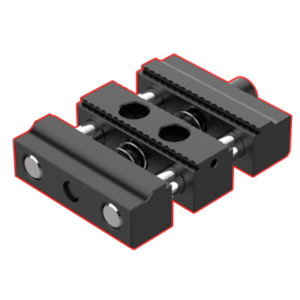
5th Axis Inc. (www.5thaxis.com) co-owner Steve Grangetto announced today that the firm would manufacture and sell pin vise fixtures for 3, 4, and 5 axis CNC machines. Pin Vises are high-precision, quality fixtures featuring a skeleton design that makes them lighter, more compact, and cost-effective.
Pin Vises have a small footprint, allowing room for more parts on a table resulting in increased throughput. Pin Vises are also lightweight making them ideal for automated applications where weight is a consideration.
“The Pin Vise design performs well. We have successfully used Pin Vises for in-house machining for years, and decided to make them available to the public,” explains co-owner Chris Taylor. “The compact design and the price point make the Pin Vises perfect for high-volume applications.”
Serrated teeth on each jaw provide maximum grip on stock less than 35HRc. Pin Vises also have built-in 45° dovetails for harder material and require less clamping force. Dovetail clamps wedge the stock down, ensuring a secure hold on much less stock than vise-mounted parts.
Available in 4” and 6” models, Pin Vises provide reliable clamping ranges of 0.25 to 2.50 inches. Pin Vises are direct mount ready from the top-down utilizing standard socket head cap screws. Operators bolt the vise directly to mounting plates, adapters, or t-slots on the machine table. 5th Axis also offers tombstones, pyramids, and plates for the Pin Vise configured with 96mm RockLock quick-change systems.
Founded in 2004, 5th Axis Inc. is an industry leader in automated production, manufacturing, and machining. 5th Axis is a turn-key solution provider serving customers around the globe focusing on product development, milling, turning, assembly, plating, finishing, and logistics.
Contact Details
Related Glossary Terms
- computer numerical control ( CNC)
computer numerical control ( CNC)
Microprocessor-based controller dedicated to a machine tool that permits the creation or modification of parts. Programmed numerical control activates the machine’s servos and spindle drives and controls the various machining operations. See DNC, direct numerical control; NC, numerical control.
- gang cutting ( milling)
gang cutting ( milling)
Machining with several cutters mounted on a single arbor, generally for simultaneous cutting.
- milling
milling
Machining operation in which metal or other material is removed by applying power to a rotating cutter. In vertical milling, the cutting tool is mounted vertically on the spindle. In horizontal milling, the cutting tool is mounted horizontally, either directly on the spindle or on an arbor. Horizontal milling is further broken down into conventional milling, where the cutter rotates opposite the direction of feed, or “up” into the workpiece; and climb milling, where the cutter rotates in the direction of feed, or “down” into the workpiece. Milling operations include plane or surface milling, endmilling, facemilling, angle milling, form milling and profiling.
- turning
turning
Workpiece is held in a chuck, mounted on a face plate or secured between centers and rotated while a cutting tool, normally a single-point tool, is fed into it along its periphery or across its end or face. Takes the form of straight turning (cutting along the periphery of the workpiece); taper turning (creating a taper); step turning (turning different-size diameters on the same work); chamfering (beveling an edge or shoulder); facing (cutting on an end); turning threads (usually external but can be internal); roughing (high-volume metal removal); and finishing (final light cuts). Performed on lathes, turning centers, chucking machines, automatic screw machines and similar machines.

